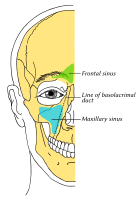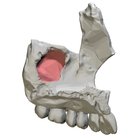Structure and Microanatomy
- Maxillary sinus is the largest air sinus in the body with a mean volume of about 10 ml.
- It is situated within the body of the maxilla and may extend into zygomatic and alveolar processes when large.
- The sinus is pyramid-shaped with the apex at the maxillary zygomatic process.
- The nasal wall presents a large aperture communicating with the nasal cavity, which is reduced in size by various bones.
- The sinus communicates through an opening into the semilunar hiatus.
- The medial wall is primarily composed of cartilage, and the posterior wall has alveolar canals transmitting vessels and nerves.
- The sinus is lined with mucoperiosteum, and the Schneiderian membrane is a bilaminar membrane with ciliated columnar epithelial cells on the internal side.
- The size of the sinuses varies in different skulls and even on the same skull.
Innervation and Relations
- The mucous membranes of the maxillary sinus receive mucomotor parasympathetic nerve fibers from the pterygopalatine ganglion.
- Sensory innervation is provided by the superior alveolar nerves.
- The roof of the sinus is also the floor of the orbit, and posterior to the sinus are the pterygopalatine fossa and infratemporal fossa.
Development and Variation
- The maxillary sinus is the first paranasal sinus to form and rapidly increases in size after puberty.
- The size of the sinus is variable in adults and may extend into zygomatic and alveolar processes.
- The roots of teeth may lie beneath the floor of the sinus or project into the sinus, with the projection more common in advanced age.
- The timing of maxillary sinus growth varies in different people.
Clinical Significance
Subtopic 4.1: Maxillary sinusitis
- Maxillary sinusitis is inflammation of the maxillary sinuses.
- Symptoms include headache, foul-smelling discharge, and systemic signs of infection.
- The skin over the involved sinus can be tender, hot, and reddened.
- Opacification of the sinus on radiographs is due to retained mucus.
- The close anatomical relation to the frontal sinus and maxillary teeth allows for easy spread of infection.
Subtopic 4.2: Oro-antral communication (OAC)
- OAC is an abnormal communication between the maxillary sinus and mouth.
- It is commonly caused by tooth extraction or iatrogenic damage during surgery.
- OAC smaller than 2mm can heal spontaneously, while larger OACs require intervention for closure.
Cancer, Age, and History
- Carcinoma of the maxillary sinus may invade the palate, block the nasolacrimal duct, cause proptosis, spread to the brain, and spread to the lymph nodes.
- With age, the enlarging maxillary sinus may surround the roots of the maxillary posterior teeth and extend into the body of the zygomatic bone.
- Loss of maxillary posterior teeth can further expand the maxillary sinus, thinning the bony floor of the alveolar process.
- Regular dental care becomes crucial to manage age-related changes in the maxillary sinus.
- The maxillary sinus was first discovered and illustrated by Leonardo da Vinci, and Nathaniel Highmore described it in detail in his 1651 treatise.
- Leonardo da Vinci's illustrations and Highmore's treatise played important roles in understanding the maxillary sinus.
The pyramid-shaped maxillary sinus (or antrum of Highmore) is the largest of the paranasal sinuses, located in the maxilla. It drains into the middle meatus of the nose through the semilunar hiatus. It is located to the side of the nasal cavity, and below the orbit.
| Maxillary sinus | |
|---|---|
 Outline of bones of face, showing position of air sinuses. Maxillary sinus is shown in blue. | |
 Left maxilla, medial view. Maxillary sinus entry shown in red. | |
| Details | |
| Artery | infraorbital artery, posterior superior alveolar artery |
| Nerve | posterior superior alveolar nerve, middle superior alveolar nerve, anterior superior alveolar nerve, and infraorbital nerve |
| Identifiers | |
| Latin | sinus maxilliaris |
| MeSH | D008443 |
| TA98 | A02.1.12.023 |
| TA2 | 780 |
| FMA | 57715 |
| Anatomical terminology | |
maxillary sinus (plural maxillary sinuses)